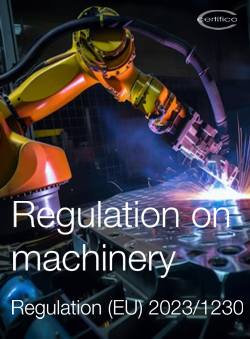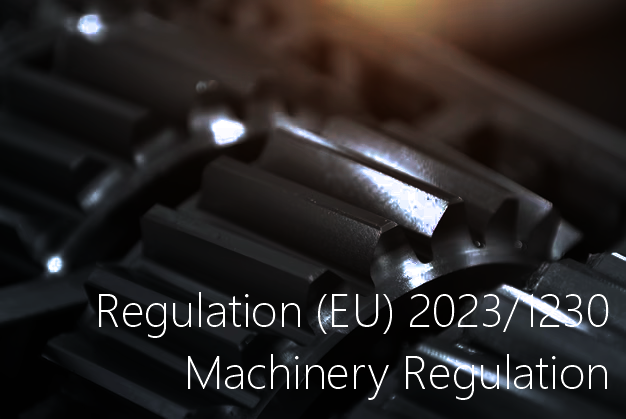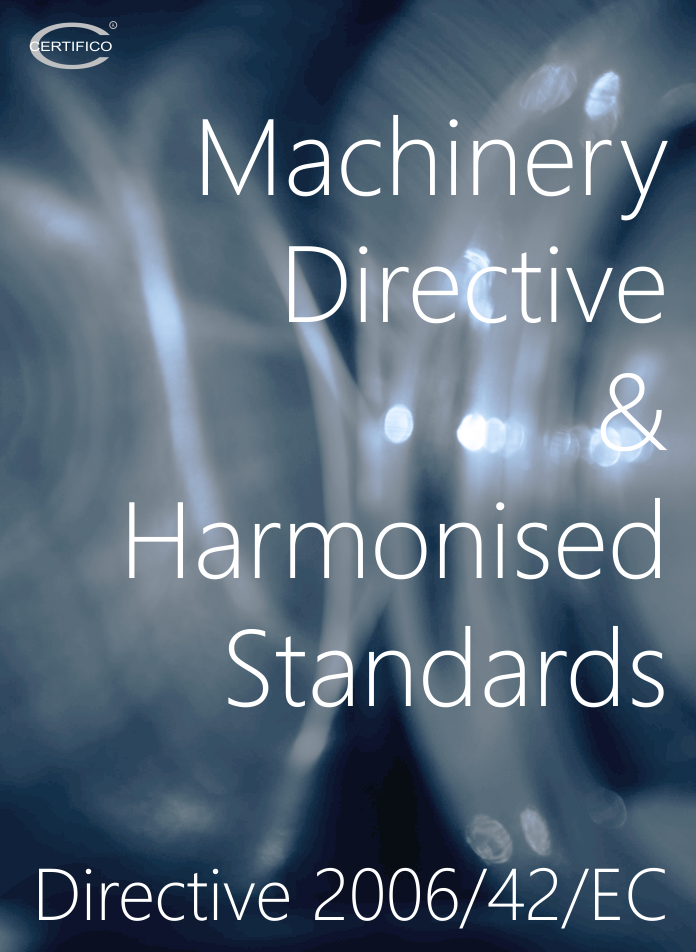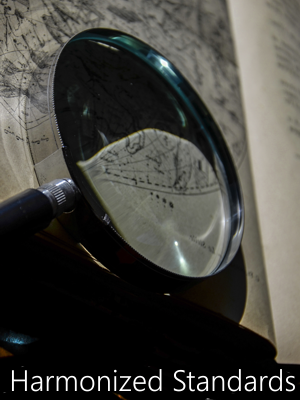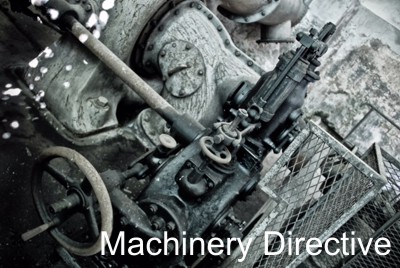Obligations
Machinery Directive 2006/42/EC application
In summary, the requirements of the Machinery Directive 2006/42/EC:
Requirements |
Rif. |
|
Procedures for assessing the conformity of machinery |
Art. 12, 13 |
|
Compliance EHSR - Application of Technical Standards Harmonized |
Art. 5, c. 1a |
|
Risk assessments |
Annex I |
|
EC declaration of conformity |
Art. 5 c.1e |
|
Declaration of incorporation of partly completed machinery |
Annex IIb |
|
Technical file for machinery |
Annex VIIa |
|
Relevant technical documentation for partly completed machinery |
Annex VIIb |
|
Instructions for the machinery |
Annex VIIa |
|
CE marking |
Art. 5 |
Risk assessment
ANNEX I
Essential health and safety requirements relating to the the design and construction of machinery
GENERAL PRINCIPLES
1. The manufacturer of machinery or his authorised representative must ensure that a risk assessment is carried out in order to determine the health and safety requirements which apply to the machinery.
The machinery must then be designed and constructed taking into account the results of the risk assessment.
By the iterative process of risk assessment and risk reduction referred to above, the manufacturer or his authorised representative shall:
- determine the limits of the machinery, which include the intended use and any reasonably foreseeable misuse thereof,
- identify the hazards that can be generated by the machinery and the associated hazardous situations,
- estimate the risks, taking into account the severity of the possible injury or damage to health and the probability of its occurrence,
- evaluate the risks, with a view to determining whether risk reduction is required, in accordance with the objective of this Directive,
- eliminate the hazards or reduce the risks associated with these hazards by application of protective measures, in the order of priority established in section 1.1.2(b).
2. The obligations laid down by the essential health and safety requirements only apply when the corresponding hazard exists for the machinery in question when it is used under the conditions foreseen by the manufacturer or his authorised representative or in foreseeable abnormal situations. In any event, the principles of safety integration referred to in section 1.1.2 and the obligations concerning marking of machinery and instructions referred to in sections 1.7.3 and 1.7.4 apply.
3. The essential health and safety requirements laid down in this Annex are mandatory; However, taking into account the state of the art, it may not be possible to meet the objectives set by them. In that event, the machinery must, as far as possible, be designed and constructed with the purpose of approaching these objectives.
4. This Annex is organised in several parts. The first one has a general scope and is applicable to all kinds of machinery. The other parts refer to certain kinds of more specific hazards. Nevertheless, it is essential to examine the whole of this Annex in order to be sure of meeting all the relevant essential requirements. When machinery is being designed, the requirements of the general part and the requirements of one or more of the other parts shall be taken into account, depending on the results of the risk assessment carried out in accordance with point 1 of these General Principles.
comment
The Machinery Directive therefore provides that the manufacturer carries out a risk assessment on the Essential Health and Safety Requirement " EHSR" in Appendix I , whereas it is PRESUMPTION OF CONFORMITY ' EHSR of compliance with Annex I, the application of the rules Harmonised techniques ( technical Standards published in the OJEU, however optional , but that the legal practice it supports the application ) , the first step you must take to the CE marking process is to identify the harmonized technical Regulations , in sequence, type C (vertical) , type B (common to groups) , type A (horizontal) , and perform the same in relation to each EHSR Annex I of the Directive, Risk assessment.
How is the Risk Assessment
To make a proper risk assessment procedure is applicable Technical Standard Harmonized EN ISO 12100 - Risk Assessment.
the steps:
1) Identification of the Technical Standards Harmonized type A, B , C.
2) If an existing standard C type (vertical) , "substantially " to consider any and Related Standards referenced in the same, the rating is carried out on the same requirements Presumption of onformity to respect the EHSR.
3) If there is a type C standard, it is necessary to examine the rules of type B and type A , the "combination" (*) of the requirements of these rules , consider any and Related Standards referenced therein, and the Evaluation of risks performed considering such a "combination" is Presumption of onformity to respect the EHSR.
(*)Required depth, not reported in this disclosure.
4) In the event that does not exist or can not be applied Harmonized Technical Standards A, B, C (or the manufacturer does not want to apply these rules , remember that it's optional application of the Harmonized Technical Regulations ) , the manufacturer may adopt its solutions techniques , however these can / need to demonstrate compliance with the EHSR (attention!).
Standards type C |
||||
| Requirements EHSR | Harmonized standards Type C |
Risk assessments EN ISO 12100 |
Compliance requirements Harmonized standars | Conformity EHSR |
| Requirement description | Requirement Harmonized standards Type C | Risk assessent on Tipe C Standards requirements | YES | YES |
Harmonized Standards Application Type A and B (combinate) |
||||
| Requirements EHSR | Harmonized standards Type A/B | Risk assessments EN ISO 12100 |
Compliance requirements Harmonized standars A/B) "combinate" | Conformity EHSR |
| Requirement description | Requirement Harmonized standards Type A/B (combiate) covered EHSR | Risk assessent on Tipe C Standards requirements on Harmonized standards Type A/B | YES | YES |
No Standards Harmonized Application |
||||
| Requirements EHSR | Norme o specifiche tecniche, metodi adottati dal costruttore | Valutazione dei rischi | Compliance with the Standards or specifications, methods adopted by the manufacturer | Conformity EHSR |
| Requirement description | The requirements of these standards, technical specifications, methods, covering the HESR (can prove) | Application Procedure for Risk Assessement on Standards, Technical Specifications, methods | YES |
YES |
ANNEX II Declarations
1. CONTENT
A. EC DECLARATION OF CONFORMITY OF THE MACHINERY
This declaration and translations thereof must be drawn up under the same conditions as the instructions (see Annex I, section 1.7.4.1(a) and (b)), and must be typewritten or else handwritten in capital letters.
This declaration relates exclusively to the machinery in the state in which it was placed on the market, and excludes components which are added and/or operations carried out subsequently by the final user.
The EC declaration of conformity must contain the following particulars:
1. business name and full address of the manufacturer and, where appropriate, his authorised representative;
2. name and address of the person authorised to compile the technical file, who must be established in the Community;
3. description and identification of the machinery, including generic denomination, function, model, type, serial number and commercial name;
4. a sentence expressly declaring that the machinery fulfils all the relevant provisions of this Directive and where appropriate, a similar sentence declaring the conformity with other Directives and/or relevant provisions with which the machinery complies. These references must be those of the texts published in the Official Journal of the European Union;
5. where appropriate, the name, address and identification number of the notified body which carried out the EC type-examination referred to in Annex IX and the number of the EC type-examination certificate;
6. where appropriate, the name, address and identification number of the notified body which approved the full quality assurance system referred to in Annex X;
7. where appropriate, a reference to the harmonised standards used, as referred to in Article 7(2);
8. where appropriate, the reference to other technical standards and specifications used;
9. the place and date of the declaration;
10. the identity and signature of the person empowered to draw up the declaration on behalf of the manufacturer or his authorised representative.
B. DECLARATION OF INCORPORATION OF PARTLY COMPLETED MACHINERY
This declaration and translations thereof must be drawn up under the same conditions as the instructions (see Annex 1, section 1.7.4.1(a) and (b)), and must be typewritten or else handwritten in capital letters.
The declaration of incorporation must contain the following particulars:
1. business name and full address of the manufacturer of the partly completed machinery and, where appropriate, his authorised representative;
2. name and address of the person authorised to compile the relevant technical documentation, who must be established in the Community;
3. description and identification of the partly completed machinery including generic denomination, function, model, type, serial number and commercial name;
4. a sentence declaring which essential requirements of this Directive are applied and fulfilled and that the relevant technical documentation is compiled in accordance with part B of Annex VII, and, where appropriate, a sentence declaring the conformity of the partly completed machinery with other relevant Directives.
These references must be those of the texts published in the Official Journal of the European Union;
5. an undertaking to transmit, in response to a reasoned request by the national authorities, relevant information on the partly completed machinery. This shall include the method of transmission and shall be without prejudice to the intellectual property rights of the manufacturer of the partly completed machinery;
6. a statement that the partly completed machinery must not be put into service until the final machinery into which it is to be incorporated has been declared in conformity with the provisions of this Directive, where appropriate;
7. the place and date of the declaration;
8. the identity and signature of the person empowered to draw up the declaration on behalf of the manufacturer or his authorised representative.
2. CUSTODY
The manufacturer of machinery or his authorised representative shall keep the original EC declaration of conformity for a period of at least 10 years from the last date of manufacture of the machinery.
The manufacturer of partly completed machinery or his authorised representative shall keep the original declaration of incorporation for a period of at least 10 years from the last date of manufacture of the partly completed machinery.
Technical file
ANNEX VII
A. Technical file for machinery
This part describes the procedure for compiling a technical file. The technical file must demonstrate that the machinery complies with the requirements of this Directive. It must cover the design, manufacture and operation of the machinery to the extent necessary for this assessment. The technical file must be compiled in one or more official Community languages, except for the instructions for the machinery, for which the special provisions of Annex I, section 1.7.4.1 apply.
1. The technical file shall comprise the following:
(a) a construction file including:
- a general description of the machinery,
- the overall drawing of the machinery and drawings of the control circuits, as well as the pertinent descriptions and explanations necessary for understanding the operation of the machinery,
- full detailed drawings, accompanied by any calculation notes, test results, certificates, etc., required to check the conformity of the machinery with the essential health and safety requirements,
- the documentation on risk assessment demonstrating the procedure followed, including:
(i) a list of the essential health and safety requirements which apply to the machinery,
(ii) the description of the protective measures implemented to eliminate identified hazards or to reduce risks and, when appropriate, the indication of the residual risks associated with the machinery,
- the standards and other technical specifications used, indicating the essential health and safety requirements covered by these standards,
- any technical report giving the results of the tests carried out either by the manufacturer or by a body chosen by the manufacturer or his authorised representative,
- a copy of the instructions for the machinery,
- where appropriate, the declaration of incorporation for included partly completed machinery and the relevant assembly instructions for such machinery,
- where appropriate, copies of the EC declaration of conformity of machinery or other products incorporated into the machinery,
- a copy of the EC declaration of conformity;
(b) for series manufacture, the internal measures that will be implemented to ensure that the machinery remains in conformity with the provisions of this Directive.
The manufacturer must carry out necessary research and tests on components, fittings or the completed machinery to determine whether by its design or construction it is capable of being assembled and put into service safely. The relevant reports and results shall be included in the technical file.
2. The technical file referred to in point 1 must be made available to the competent authorities of the Member States for at least 10 years following the date of manufacture of the machinery or, in the case of series manufacture, of the last unit produced.
The technical file does not have to be located in the territory of the Community, nor does it have to be permanently available in material form. However, it must be capable of being assembled and made available within a period of time commensurate with its complexity by the person designated in the EC declaration of conformity.
The technical file does not have to include detailed plans or any other specific information as regards the sub-assemblies used for the manufacture of the machinery unless a knowledge of them is essential for verification of conformity with the essential health and safety requirements.
3. Failure to present the technical file in response to a duly reasoned request by the competent national authorities may constitute sufficient grounds for doubting the conformity of the machinery in question with the essential health and safety requirements.
B. Relevant technical documentation for partly completed machinery
This part describes the procedure for compiling relevant technical documentation. The documentation must show which requirements of this Directive are applied and fulfilled. It must cover the design, manufacture and operation of the partly completed machinery to the extent necessary for the assessment of conformity with the essential health and safety requirements applied.
The documentation must be compiled in one or more official Community languages.
It shall comprise the following:
(a) a construction file including:
- the overall drawing of the partly completed machinery and drawings of the control circuits,
- full detailed drawings, accompanied by any calculation notes, test results, certificates, etc., required to check the conformity of the partly completed machinery with the applied essential health and safety requirements,
- the risk assessment documentation showing the procedure followed, including:
(i) a list of the essential health and safety requirements applied and fulfilled,
(ii) the description of the protective measures implemented to eliminate identified hazards or to reduce risks and, where appropriate, the indication of the residual risks,
(iii) the standards and other technical specifications used, indicating the essential health and safety requirements covered by these standards,
(iv) any technical report giving the results of the tests carried out either by the manufacturer or by a body chosen by the manufacturer or his authorised representative,
(v) a copy of the assembly instructions for the partly completed machinery;
(b) for series manufacture, the internal measures that will be implemented to ensure that the partly completed machinery remains in conformity with the essential health and safety requirements applied.
The manufacturer must carry out necessary research and tests on components, fittings or the partly completed machinery to determine whether by its design or construction it is capable of being assembled and used safely. The relevant reports and results shall be included in the technical file.
The relevant technical documentation must be available for at least 10 years following the date of manufacture of the partly completed machinery or, in the case of series manufacture, of the last unit produced, and on request presented to the competent authorities of the Member States. It does not have to be located in the territory of the Community, nor does it have to be permanently available in material form. It must be capable of being assembled and presented to the relevant authority by the person designated in the declaration for incorporation.
Failure to present the relevant technical documentation in response to a duly reasoned request by the competent national authorities may constitute sufficient grounds for doubting the conformity of the partly completed machinery with the essential health and safety requirements applied and attested.
ANNEX VI - Assembly instructions for partly completed machinery
The assembly instructions for partly completed machinery must contain a description of the conditions which must be met with a view to correct incorporation in the final machinery, so as not to compromise safety and health.
The assembly instructions must be written in an official Community language acceptable to the manufacturer of the machinery in which the partly completed machinery will be assembled, or to his authorised representative.
Instructions
1.7.4. Instructions
All machinery must be accompanied by instructions in the official Community language or languages of the Member State in which it is placed on the market and/or put into service.
The instructions accompanying the machinery must be either "Original instructions" or a "Translation of the original instructions", in which case the translation must be accompanied by the original instructions.
By way of exception, the maintenance instructions intended for use by specialised personnel mandated by the manufacturer or his authorised representative may be supplied in only one Community language which the specialised personnel understand.
The instructions must be drafted in accordance with the principles set out below.
1.7.4.1. General principles for the drafting of instructions
(a) The instructions must be drafted in one or more official Community languages. The words "Original instructions" must appear on the language version(s) verified by the manufacturer or his authorised representative.
(b) Where no "Original instructions" exist in the official language(s) of the country where the machinery is to be used, a translation into that/those language(s) must be provided by the manufacturer or his authorised representative or by the person bringing the machinery into the language area in question. The translations must bear the words "Translation of the original instructions".
(c) The contents of the instructions must cover not only the intended use of the machinery but also take into account any reasonably foreseeable misuse thereof.
(d) In the case of machinery intended for use by non-professional operators, the wording and layout of the instructions for use must take into account the level of general education and acumen that can reasonably be expected from such operators.
1.7.4.2. Contents of the instructions
Each instruction manual must contain, where applicable, at least the following information:
(a) the business name and full address of the manufacturer and of his authorised representative;
(b) the designation of the machinery as marked on the machinery itself, except for the serial number (see section 1.7.3);
(c) the EC declaration of conformity, or a document setting out the contents of the EC declaration of conformity, showing the particulars of the machinery, not necessarily including the serial number and the signature;
(d) a general description of the machinery;
(e) the drawings, diagrams, descriptions and explanations necessary for the use, maintenance and repair of the machinery and for checking its correct functioning;
(f) a description of the workstation(s) likely to be occupied by operators;
(g) a description of the intended use of the machinery;
(h) warnings concerning ways in which the machinery must not be used that experience has shown might occur;
(i) assembly, installation and connection instructions, including drawings, diagrams and the means of attachment and the designation of the chassis or installation on which the machinery is to be mounted;
(j) instructions relating to installation and assembly for reducing noise or vibration;
(k) instructions for the putting into service and use of the machinery and, if necessary, instructions for the training of operators;
(l) information about the residual risks that remain despite the inherent safe design measures, safeguarding and complementary protective measures adopted;
(m) instructions on the protective measures to be taken by the user, including, where appropriate, the personal protective equipment to be provided;
(n) the essential characteristics of tools which may be fitted to the machinery;
(o) the conditions in which the machinery meets the requirement of stability during use, transportation, assembly, dismantling when out of service, testing or foreseeable breakdowns;
(p) instructions with a view to ensuring that transport, handling and storage operations can be made safely, giving the mass of the machinery and of its various parts where these are regularly to be transported separately;
(q) the operating method to be followed in the event of accident or breakdown; if a blockage is likely to occur, the operating method to be followed so as to enable the equipment to be safely unblocked;
(r) the description of the adjustment and maintenance operations that should be carried out by the user and the preventive maintenance measures that should be observed;
(s) instructions designed to enable adjustment and maintenance to be carried out safely, including the protective measures that should be taken during these operations;
(t) the specifications of the spare parts to be used, when these affect the health and safety of operators;
(u) the following information on airborne noise emissions:
- the A-weighted emission sound pressure level at workstations, where this exceeds 70 dB(A); where this level does not exceed 70 dB(A), this fact must be indicated,
- the peak C-weighted instantaneous sound pressure value at workstations, where this exceeds 63 Pa (130 dB in relation to 20 μPa),
- the A-weighted sound power level emitted by the machinery, where the A-weighted emission sound pressure level at workstations exceeds 80 dB(A).
These values must be either those actually measured for the machinery in question or those established on the basis of measurements taken for technically comparable machinery which is representative of the machinery to be produced.
In the case of very large machinery, instead of the A-weighted sound power level, the A-weighted emission sound pressure levels at specified positions around the machinery may be indicated.
Where the harmonised standards are not applied, sound levels must be measured using the most appropriate method for the machinery. Whenever sound emission values are indicated the uncertainties surrounding these values must be specified. The operating conditions of the machinery during measurement and the measuring methods used must be described.
Where the workstation(s) are undefined or cannot be defined, A-weighted sound pressure levels must be measured at a distance of 1 metre from the surface of the machinery and at a height of 1,6 metres from the floor or access platform. The position and value of the maximum sound pressure must be indicated.
Where specific Community Directives lay down other requirements for the measurement of sound pressure levels or sound power levels, those Directives must be applied and the corresponding provisions of this section shall not apply;
(v) where machinery is likely to emit non-ionising radiation which may cause harm to persons, in particular persons with active or non-active implantable medical devices, information concerning the radiation emitted for the operator and exposed persons.
1.7.4.3. Sales literature
Sales literature describing the machinery must not contradict the instructions as regards health and safety aspects. Sales literature describing the performance characteristics of machinery must contain the same information on emissions as is contained in the instructions.
- Published: 07 November 2013
- Hits: 19645










